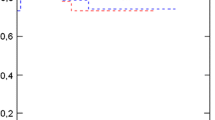Abstract
Breast cancers in BRCA1 gene mutation carriers often have specific histologic features: grade III tumors with pushing margins. Our purpose was to compare the mammographic and histologic features of breast cancers in carriers with those in age-matched sporadic controls. The features of breast cancers in 27 BRCA1 carriers found during annual surveillance were compared to those in 107 age-matched sporadic controls. The carriers had no (classic) spiculated mammographic lesions, a high percentage of well-defined masses and hardly any masses with microcalcifications, whereas the controls had significantly fewer well-defined ones and only in 27% spiculated lesions on the mammogram. The well-defined mammographic tumors correlated in 83% of the carriers and in 70% of the controls with histologic circumscribed tumor margins. Spiculated mammographic lesions in the controls were in 90% grade I or II tumors. DCIS with or without infiltration was seen in 22% of the carriers and in 45% of the controls. In conclusion, breast cancers diagnosed in BRCA1 carriers do not have classic malignant mammographic features. A minority of the young sporadic controls show the classic malignant lesion on the mammogram. Both carriers and controls generally show a good correlation between their mammographic- and histologic tumor pattern.
Similar content being viewed by others
References
Breast Cancer Linkage Consortium (1997) Pathology of familial breast cancer: differences between breast cancer in carriers of BRCA1 or BRCA2 mutations and sporadic cases. Lancet 349:1505–1510
Lakhani SR, Jacquemier J, Sloane JP, Gusterson BA, Anderson TJ, Vijver MJ van der et al (1998) Multifactorial analysis of differences between sporadic breast cancers and cancers involving BRCA1 and BRCA2 mutations. J Natl Cancer Inst 1998 90:1138–1145
Armes JE, Egan AJM, Southey MC, Dite GS, McCredie MRE, Giles GG et al (1998) The histologic phenotypes of breast carcinoma occurring before age 40 years in women with and without BRCA1 or BRCA2 germline mutations. Cancer 83:2335–2345
Lidereau R, Eisinger F, Champeme M-H, Nogues C, Bieche I, Birnbaum D et al (2000) Major improvement in the efficacy of BRCA1 mutation screening using morphoclinical features of breast cancer. Cancer research 60:1206–1210
Nixon AJ, Neuberg D, Hayes DF, Gelman R, Connolly JL, Schnitt S et al (1994) Relationship of patient age to pathologic features of the tumor and prognosis for patients with stage I or II breast cancer. J Clin Oncol 12:888–894
Sidoni A, Cavaliere A, Bellezza G, Scheibel M, Bucciarelli E (2003) Breast cancer in young women: clinicopathological features and biological specificity. Breast 12:247–250
Vrieling C, Collette L, Fourquet A, Hoogenraad WJ, Horiot J-C, Jager JJ et al (2003) Can patient-, treatment- and pathology-related characteristics explain the high local recurrence rate following breast-conserving therapy in young patients? Eur J Cancer 39:932–944
Lakhani SR, Vijver MJ vd, Jacquemier J, Anderson TJ, Osin PP, McGuffog L et al (2002) The pathology of familial breast cancer: predictive value of immunohistochemical markers estrogen receptor, progesterone receptor, HER-2, and p53 in patients with mutations in BRCA1 and BRCA2. J Clin Oncol 20:2310–2318
Gils CH van, Otten JDM, Verbeek ALM, Hendriks JHCL (1995) Short communication: breast parenchymal patterns and their changes with age. Br J Radiol 68:1133–1135
Huo Z, Giger Ml, Olopade OI, Wolverton DE, Weber BL, Metz CE et al (2002) Computerized analysis of digitized mammograms of BRCA1 and BRCA2 gene mutation carriers. Radiology 225:519–526
Kaas R, Kroger R, Hendriks JHCL, Besnard APE, Koops W, Pameijer FA et al (2004) The significance of circumscribed malignant mammographic masses in the surveillance of BRCA1/2 gene mutation carriers. Eur Radiol 14:1647–1653
Malone KE, Daling JR, Neal C, Suter NM, O’Brien C, Cushing-Haugen K et al (2000) Frequency of BRCA1/BRCA2 mutations in a population-based sample of young breast carcinoma cases. Cancer 88:1393–1402
Papelard H, Bock GH de, Eijk R van, Vliet Vlieland TPM, Cornelisse CJ, Devilee P, Tollenaar RAEM (2000) Prevalence of BRCA1 in a hospital-based population of Dutch breast cancer patients. BrJCancer 83:719–724
Tabar L, Dean PB. Teaching atlas of mammography. Second revised edition (1985) Georg Thieme Verlag Stuttgart, New York
Mammography 4th edition (2003). In: ACR Breast imaging reporting and data system, Breast imaging atlas. Reston VA American College of Radiology
Kopans DB (1998) Breast imaging, second edition Lippincott-Raven publishers, Philadelphia
Tabar L, Tot T, Dean PB (2005) Breast Cancer. The art and science of early detection with mammography Georg Thieme Verlag Stuttgart, New York
Hamilton LJ, Evans AJ, Wilson ARM, Scott N, Cornford EJ, Pinder SE et al (2004). Breast imaging findings in women with BRCA1- and BRCA2-associated breast carcinoma. Clinical Radiology 59:895–902
Tilanus-Linthorst M, Verhoog L, Obdeijn IM, Bartels K, Menke-Pluymers M, Eggermont A et al (2002) A BRCA1/2 mutation, high breast density and prominent pushing margins of a tumor independently contribute to a frequent false-negative mammography. Int J Cancer 102:91–95
Zonderland HM, Pope Jr ThL, Nieborg AJ (2004) The positive predictive value of the breast imaging reporting and data system (BI-RADS) as a method of quality assessment in breast imaging in a hospital population. Eur Radiol 14:1743–1750
Acknowledgment
The authors are grateful to Prof dr BBR Kroon for his invaluable advice and critical comments on earlier drafts of this manuscript.
Author information
Authors and Affiliations
Corresponding author
Rights and permissions
About this article
Cite this article
Kaas, R., Kroger, R., Peterse, J.L. et al. The correlation of mammographic-and histologic patterns of breast cancers in BRCA1 gene mutation carriers, compared to age-matched sporadic controls. Eur Radiol 16, 2842–2848 (2006). https://doi.org/10.1007/s00330-006-0385-0
Received:
Revised:
Accepted:
Published:
Issue Date:
DOI: https://doi.org/10.1007/s00330-006-0385-0




